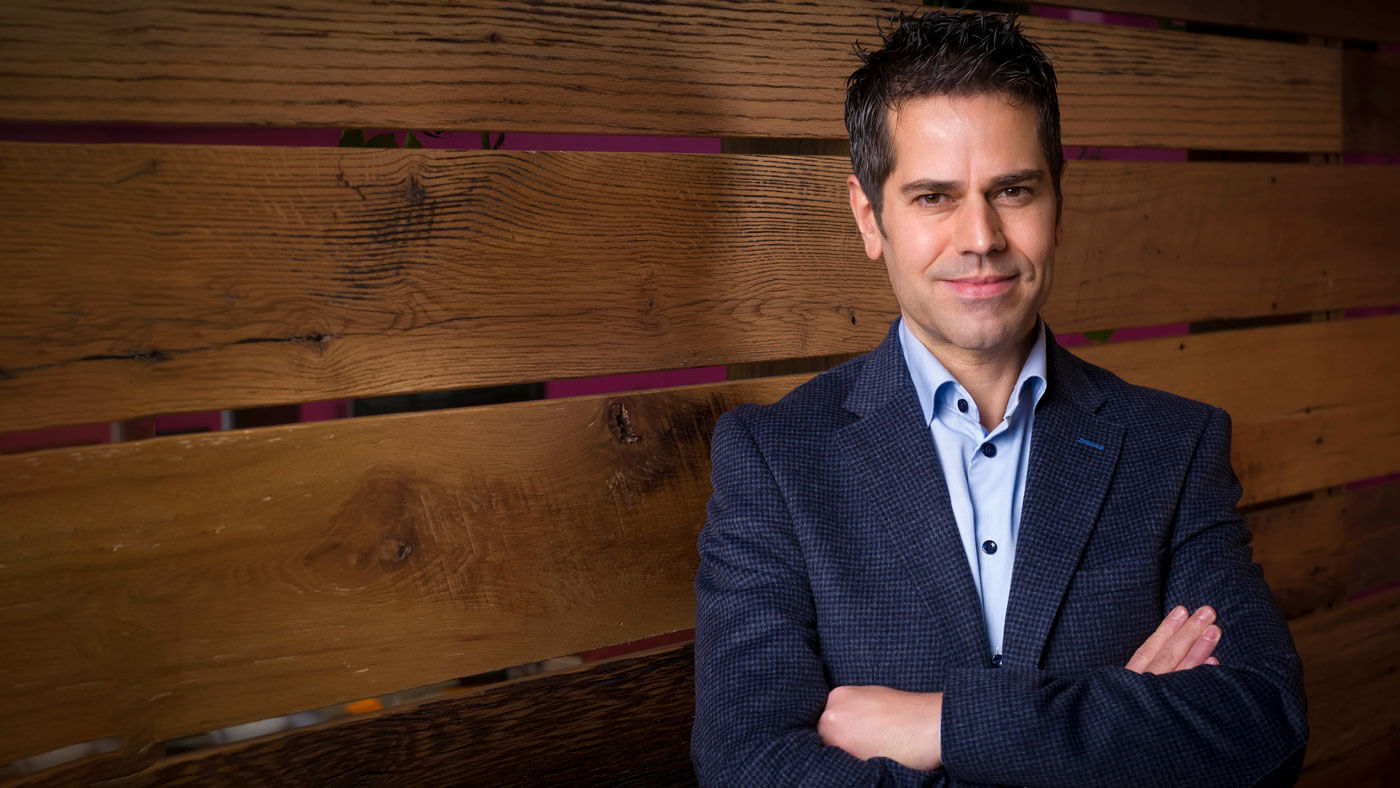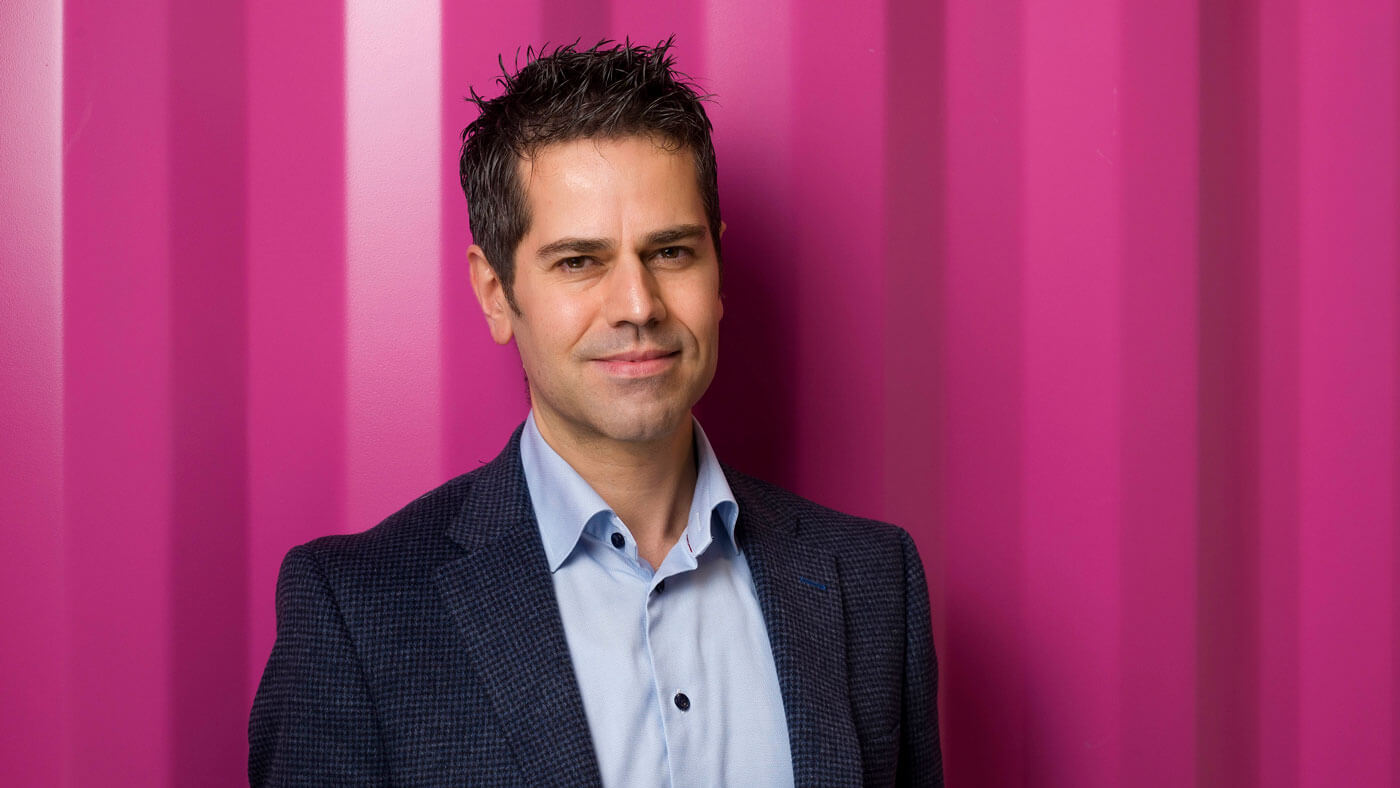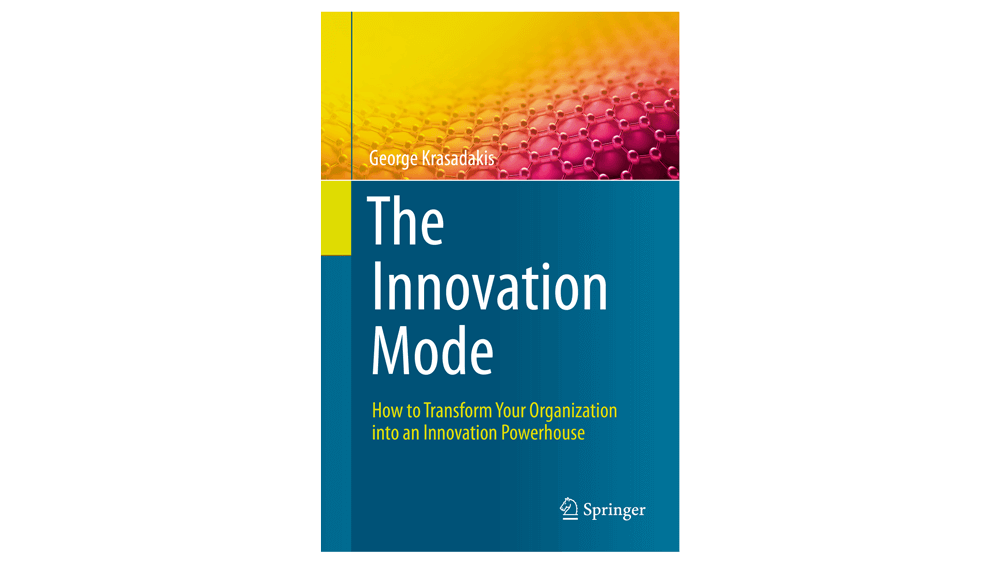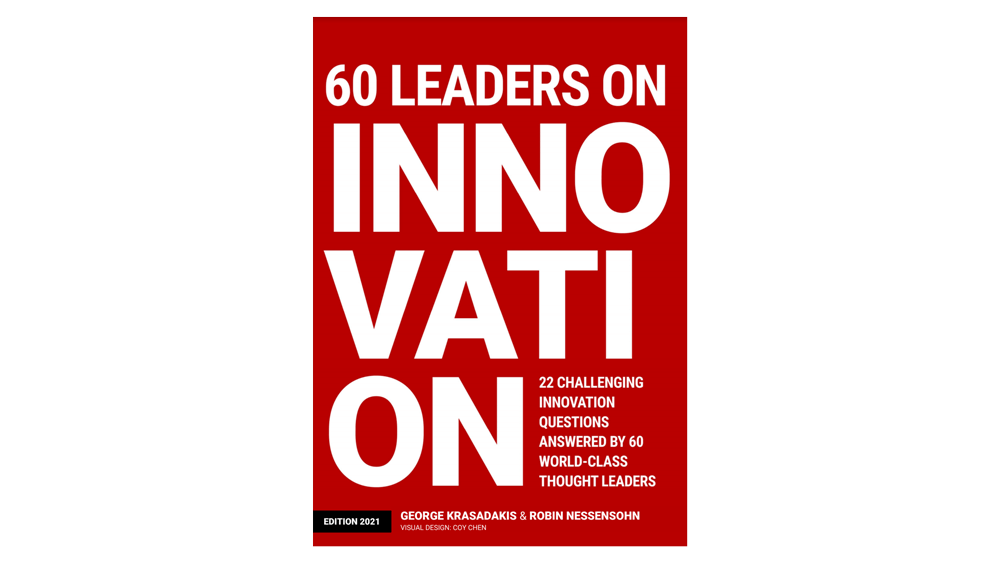Getting organizations to the Innovation Mode with George Krasadakis
We continue our series of interviews of leading global innovation experts with a discussion together with George Krasadakis, a 20-year innovation veteran and the author of The Innovation Mode book.
In this interview, George shares his thoughts on some of the challenges large organizations typically have with their innovation work, and also provides pragmatic, practical tips on how to start moving towards a mode where the organization can make innovation happen at scale.

Table of contents
Could you tell us a little bit about yourself and your background?
I am George Krasadakis – the author of ‘The Innovation Mode’. I am passionate about innovation, technology and product development and, as an advisor, I help corporations innovate and adopt elements of the startup mindset into their work.
For two decades now, I’ve had various innovation and digital product leadership roles for technology startups, consulting firms, and big tech companies. I have architected and built corporate innovation frameworks, gamification programs, innovation labs, and ideation systems, including an innovative blockchain-based open innovation platform that enables ideators to sign their ideas on a public blockchain.
I have a technical background – a combination of Computational Statistics, Software Engineering, and Product Development. I am originally from Greece, but I now live in Ireland.
A big part of what I loved about your book The Innovation Mode is how pragmatic it really is. Can you talk about the process of writing the book, and share the main takeaways from it?
I suppose that my inspiration for writing this book came from the realization that in the corporate world, there is confusion about what innovation is. Throughout my - rather adventurous - career I have worked for and together with more than 20 multinationals, and I have witnessed the lack of a sufficient understanding of the innovation principles and capabilities that enable a company to systematically innovate.
Even within a given company, people are often not aligned in terms of their understanding of innovation, its methods, and its importance. This realization, combined with the fact that I have seen innovation from various angles – as an innovator, inventor, startup founder, innovation leader, technology director, etc. – became the primary driver for writing the book. My objective with the ‘Innovation Mode’ is to present corporate innovation with clarity and simplicity - through an applied, practical approach.
The process of creating the book was really rewarding. I started from a blank page, thinking as a business leader who is determined to drive innovation in their company. For more than a year, I had been dealing with questions like ‘How should we start with corporate innovation’, ‘What is the role of technology and what are the key processes that need to be remodeled’ or ‘What is the role of people and how can we define a culture of innovation’.
I used my 20+ years of experience along with proven innovation methods and novel ideas on how to set up a corporate innovation framework and shape an innovation transformation masterplan.
The main message is that every company can reach the ‘Innovation Mode’ - a special mode of operation where innovation happens ‘naturally’. This is achieved when all the innovation processes and related behaviors are fully embedded in the ‘operating system’ of the company.
The book sets this ‘Innovation Mode’ as the target and explains how to get there – by adopting the right technologies, processes, and cultural improvements that help the organization become highly responsive to signals from the market – by means of ideation, fast experimentation, concept validation, and product development. It explains how to architect a company as a truly innovative and agile organization.
The book also presents the importance of the innovation culture and recommends various ‘hacks’ to make the organizational structure less rigid and easier to navigate. It explains the importance of forming an ‘active community of innovators’.
At the technology and process level, the book defines an essential ‘innovation framework’ – a set of key capabilities that help organizations to become more innovative. Among other capabilities, this framework contains an idea management system enabling companies to organize a corpus of ideas that are handled as innovation assets, an ‘innovation intelligence’ service enabling the company to ‘listen’ to the market, a ‘measurement framework’ for innovation along with components for effective ‘information and knowledge sharing’.
In your experience, what are the most common challenges or barriers to driving innovation in large organizations?
Innovation in large corporate environments typically suffers from bureaucracy, politics, a risk-avoidance mindset, and a general ‘disconnect’ from the organizational purpose – and these blockers can be seen even in companies that are truly determined to innovate.
In many cases, I’ve seen great ideas being abandoned due to inertia or political reasons – e.g., when, in absence of an objective ‘opportunity evaluation’ framework, ‘political’ interventions impact innovation investments. In other cases, I’ve seen organizational complexity and bureaucracy blocking corporate innovation – for example when innovators get frustrated while trying to navigate the organizational structure in search of the right stakeholders to pitch their ideas and seek support.
On the other hand, I have witnessed small but inspired startup teams that managed to produce impressive solutions, surprisingly fast, with extremely limited resources. What makes the difference in such cases, is the belief in the purpose, the mission, and the vision of the company along with the true agility of the team – its ability to learn quickly and pivot as needed. This is the ‘startup mindset’ that corporations need to adopt.
What makes the difference is the belief in the purpose, the mission, and the vision of the company along with the true agility of the team – its ability to learn quickly and pivot as needed.
Another frequent point of failure is when corporate leaders fail to convince their people of the importance of innovation in their context. I mean, it is easy to set up fancy collaboration spaces, organize innovation events, hackathons, or even establish an impressive innovation lab – but without a strong link to the organizational purpose and key results, there is a risk to end up with the so-called ‘innovation theatre’. In such cases, the initial excitement quickly fades away due to the absence of meaningful outputs and outcomes.
Ironically, such ‘lightweight’ or ‘on the surface’ innovation programs can even damage the ability of the organization to innovate – as people quickly realize that fancy innovation activities alone cannot serve the business goals of the company.
Finally, I would highlight limited ‘innovation education’ as a frequent blocker for corporate innovation. Very often, there is no consistent and contextualized innovation process for the company, there is no shared understanding of the key principles, and no ‘standard innovation language’. This prevents alignment on what innovation means in the context of the company and allows confusion around the tools, the methods, and the innovation processes. Companies do need a framework for innovation and a strong innovation leadership on top of it.
How do you define ‘innovation culture’, and how should leaders attempt to shape one?
The ‘culture of innovation’ is another overused term, that needs proper definition. In the Innovation Mode, I define it as the collective mindset that values and promotes curiosity (exploration of new ideas) and change (adoption of new ideas) as key success factors for the organization, holistically. It is a system of values and principles that inspire and empower people to collaborate effectively toward big organizational goals.
As I explain in the Innovation Mode, the ‘system of values’ of an innovation culture is based upon six principles, namely Trust, Safety, Openness, Curiosity, Purposefulness, and Healthy Competition. When these principles are there people tend to be more open, creative, and efficient - they engage more with the innovation process, they become more proactive, they share their ideas and contribute to others’ ideas in constructive and creative ways. At the same time, the leadership is also more open, accessible, and collaborative – they engage with innovation activities and provide direct and constructive feedback.
The ‘system of values’ of an innovation culture is based upon six principles: Trust, Safety, Openness, Curiosity, Purposefulness, and Healthy Competition.
The culture of innovation starts evolving when a critical mass of people engages with the innovation function as a means of pursuing the purpose of the organization. You will know when this special culture is truly adopted when you see leaders in your company accepting failure as part of the innovation process; when people are not afraid of failure and feel part of “one team” working toward a bold organizational purpose; when they feel empowered and encouraged to engage with formal or informal innovation activities.
To shape an innovation culture, leaders must first realize that it cannot be simply fixed, on-demand – and this is one of the most common mistakes I’ve seen in the market: you cannot simply adopt a ‘better culture’ or run a program and make your people more open to innovation; you cannot bring a vendor in to change your culture. Whatever improvements you get out of such initiatives will only be ephemeral.
You cannot bring in a vendor to change your culture, it can only grow organically and evolve from within.
Leaders must realize that an innovation culture can only grow organically – it can only evolve from within. Shaping a culture of innovation is a long-term investment - a journey of inspiration and leadership, powered by authentic, strong messages and genuine leadership behaviors that link innovation with the purpose of the company.
As a leader, you must first obtain a good understanding of the current state of the culture in your company – to become fully aware of the blockers, blind spots, and gaps that prevent people from engaging with innovation. For example, the organization may realize that people need additional resources (it could be digital tools, innovation methods, templates, content, etc.) or that people perceive the innovation process as slow and complex; or that they are not encouraged by their managers to participate in innovation events.
Based on such findings, the company could design and orchestrate initiatives that improve the existing innovation tools and methods, provide related educational programs, and establish more effective communication channels for innovation. It is important to note here that this is not an isolated ‘fix the culture’ project but rather a continuous, ongoing process of improving and protecting the innovation culture. At the core of this process, I see a self-organizing community of inspired innovators.
Another prerequisite for an authentic innovation culture is transparency and access to knowledge. In this direction, I always advise my clients to implement an ‘Innovation Portal’ as a digital ‘home for innovation’. This is the place where people discover and share anything innovation-related; where they discover innovation stories and share their learnings.
When such an innovation portal exists, people can easily see how the organizational purpose links to innovation initiatives and projects; they discover real examples of how innovation drives value for the business and they connect with other innovators within the organization.
It is important to note that you can’t ‘fix the culture’ in isolation, but rather need a continuous, ongoing process of improving and protecting the innovation culture through practical changes.
Through such an Innovation Portal, leaders themselves are more present – they diffuse strong messages about the importance of innovation, recognize and reward innovators; they advocate for the fail-safe fail-fast principles, and promote real projects that demonstrate how innovation serves the organizational purpose. Also, the Innovation Portal can become the basis for the formation and empowerment of the informal community of innovators I mentioned previously.
This is very important because those inspired innovators both produce innovation results and promote innovation – they lead by example and attract the attention of people from the broader organization. On top of all these, a carefully designed gamification system can bring incredible results in promoting innovation and boosting the culture.
These are just some of the key investment areas for shaping a strong culture of innovation. It is important to understand that, obtaining and maintaining a strong innovation culture needs ongoing orchestration that must become part of the ‘operating system’ of the organization.
How would you advise innovators go from an idea to concept and eventually a product, any practical tips on how to best succeed at this process?
I strongly believe that what differentiates a truly innovative company is the ability to quickly spot and validate innovation opportunities. A systematic, streamlined approach to ‘opportunity discovery’ improves the chances of spotting promising, big opportunities at the right time. This allows better prioritization and innovation investment decisions, which results in a healthier portfolio of products to be built and driven to the market.
The problem is that people tend to overcomplicate this process – they often add too much governance with multiple stage-gates, requirements for lengthy documentation, long assessment procedures, unnecessary interdependencies, and bureaucratic decision-making. This approach slows down the entire innovation pipeline and severely impacts its throughput.
People tend to overcomplicate the opportunity discovery process, which slows down the entire innovation pipeline and severely impacts its throughput.
I often advise my clients to rethink their opportunity discovery process as a simple, fast, and agile ‘system’ that is well-understood and adopted by all. Some of the most important components of this system – such as the ‘idea intake’, the ‘assessment of ideas’, the ‘concept validation’ and the ‘MVP development’ - can be abstracted and streamlined as independent services. This increases the pace of innovation, enables clear accountability, and allows accurate performance measurement and insights.
For example, the ‘Prototype Factory’ as presented in the Innovation Mode, could be one of these independent, core services. This is an optimized ‘concept validation capability’ run by a team of experts who know when and how to validate an idea or a product concept. This special team understands deeply the ‘state of the art’ technologies, are fully aware of the competition and emerging market trends, and master methods related to prototyping, user research, and product development. They leverage reusable software components, templates, UI elements, and frameworks, and they use low/no-code platforms to build realistic, inexpensive prototypes in no time.

Beyond that, they apply the most appropriate validation techniques – by exposing the prototype to real users and gathering data and feedback. The Prototype Factory delivers not just prototypes, but data-backed, justified recommendations about the next best steps for each product concept – e.g., hold, revise, pivot, proceed, etc. The Prototype Factory hides the complexity regarding prototyping and testing, increases the pace of innovation, and boosts the ‘opportunity discovery bandwidth’ of the organization.
In general, I would advise innovation leaders to invest in educating their organizations on the topics of experimentation and prototyping – I think it is essential to establish a ‘shared innovation language’ across the company – also covering product development and experimentation terminology. For example, everybody must understand what a ‘prototype’ is, how it is different from an MVP and when each of these comes to play. Business stakeholders must have a clear view of how experimentation can be used to improve decision-making and how failure is part of the innovation process. This is essential as it helps in both expectation management and better utilization of resources.
Many of our readers are working on innovation at organizations that aren’t quite in the “Innovation Mode” yet, where would you advise they start?
To move closer to the ’Innovation Mode’, you need to first understand where you stand in reference to the ’ideal state’. Hence, I think that the most important step is to perform a ’self-assessment’ in terms of the ’innovation maturity’ of your organization.
This will tell you how mature your company is - in terms of capabilities, culture, innovation outputs, and outcomes and how far you are from the ’ideal innovation architecture’. The latter must be defined specifically for your company - e.g. the ideal innovation architecture after considering the mission, size, sector of your company, the type of services/products offered, etc.
To move closer to the ’Innovation Mode’, you need to first understand where you stand in reference to the ’ideal state’.
The assessment comes as a ’gap analysis’ presenting the missing elements in terms of technologies, processes, resources, educational programs, or even organizational design. The report should then be used to prioritize the needs, define potential solutions and then construct a strategic roadmap presenting how to move towards the ’Innovation Mode’.
This is an excellent way to obtain awareness about the current vs ideal state, capture insights regarding the elements that must be added to the scheme, and ensure alignment in terms of planning and ownership.
You’ve worked with many innovators and innovation leaders. What traits set the successful ones apart from the rest?
On top of the typical innovation skillset, I think that there are three characteristics or behaviors that make the biggest difference.
First, successful innovation leaders are purpose-driven. They get passioned or even obsessed with the big purpose they are serving, and the problems they are trying to solve; they use their bold vision to put their creative energy in the right direction and inspire others to join the effort. Hence, having the ability to shape, articulate and advocate a bold vision is critical for innovation leadership.
Second, successful innovators are inherently curious – they have an experimentation mindset and they see failure as part of the process. They tend to question things in a constructive way and challenge the status quo – how things work and why they work in a given way. Having this mindset can prove to be a valuable source of ideas and innovation opportunities - and also a source of inspiration and leadership for fellow innovators.
Finally, true innovators have a special mindset regarding collaboration – they are ’open’ to sharing their thoughts and ideas, they realize that innovation succeeds when great minds work together to solve big problems; when people share their knowledge and expertise; when they are open to constructive feedback. Accomplishing anything significant alone is an uphill battle.
Any closing thoughts?
I’d just like to conclude that in the spirit of information sharing and open collaboration, I welcome all of your readers to download a free copy of the ’60 Leaders on Innovation’ ebook, which we published recently, here.
The 280 page ebook is comprised of 22 chapters, each representing a key question around innovation, and has multiple answers to each of them from a total of 60 recognized innovation leaders representing the different points of view and backgrounds they have. It’s a great source of practical innovation wisdom in a convenient, easy-to-read package of bite-sized answers.
Interested in Innovation and Leadership?
Join 90k+ other monthly readers and subscribe to our blog to get the latest stories on innovation, leadership and culture straight to your inbox.







